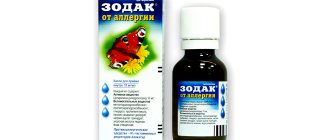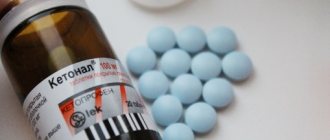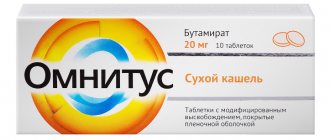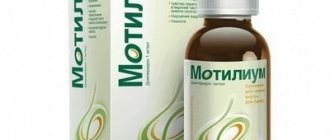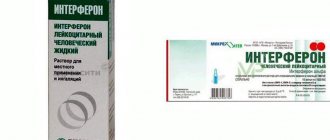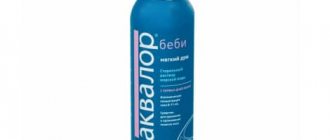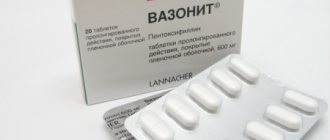Suprastin is given to children with pronounced allergy symptoms. Belongs to the group of fast-acting antihistamines. Suprastin can be given to newborns and infants, which cannot be said about analogues. The disadvantages of the medicine include the tablet form, which is inconvenient for children under one year of age. There is no children's form of Suprastin in drops, syrup or suspension. Before use, the tablet will have to be crushed into powder and mixed with liquid. Be sure to read the instructions for use, at what age, how many days you can take the medicine and the list of contraindications, because some children cannot be given Suprastin.
Instructions for use
The tablets should be swallowed whole during meals, with a sufficient volume of liquid.
The medication in ampoules is administered intramuscularly. Medicine can be administered into a vein only in severe cases and under the supervision of a doctor.
The dosage regimen for each child is selected individually depending on age, liver and kidney function:
| Age | Pills | Injections |
| Up to a year | You need to give the medication 1/4 tablet twice or thrice a day. | The medicine is administered intramuscularly in a dose of 0.25 ml. |
| 1-6 years | Take the drug ¼ tablet three times a day or ½ tablet twice a day. | The drug should be administered into the muscle at a dose of 0.5 ml. |
| 6-14 years | Take 0.5 tablets twice or thrice a day. | The medication is injected into the muscle in 0.5 or 1 ml. |
| Over 14 years old | You need to give the medicine 1 tablet three or four times a day. | The drug should be injected into the muscle in 1 or 2 ml. |
If the medicine is well tolerated, the dosage can be gradually increased. The highest dosage should not be more than 2 mg per kg of weight.
If there is liver or kidney dysfunction, the doctor may reduce the dosage of the medication.
Forms of the drug
The main active ingredient of Suprastin is chloropyramine hydrochloride, an amino acid familiar to the body. The tablets act on the histamine receptors of cells that are exposed to allergens. By blocking their work, Suprastin reduces the manifestations of allergies.
In addition to Suprastin tablets with a dosage of 25 mg, the drug is available in pharmacies in the form of 20 mg ampoules. The solution is sold in packs of 5 ampoules and contains water for injection. To treat at home, you must have the skills to administer injections to children.
Suprastin injections are given intramuscularly or into a vein if there is an urgent need to relieve severe allergy symptoms - Quincke's edema, convulsions, attacks of suffocating cough. In other cases, children are prescribed tablets.
Injections are also used for lactose intolerance or digestive problems - ulcers or exacerbation of gastritis. The injection is calculated from the dosage of “1 mg per 1 kg of body weight.” The injection is placed in the upper right square of the buttock. This is enough to enter the blood and eliminates the possibility of the needle hitting a nerve.
Side effects
The medicine Suprastin in children can cause the following undesirable reactions:
- excessive excitement, drowsiness, fatigue, headaches, trembling of individual parts of the body, euphoria;
- lack or increased appetite, discomfort in the abdomen, dry mouth, nausea, vomiting, upset stomach, stool retention, abdominal pain;
- hypotension, increased heart rate, cardiac arrhythmia;
- muscle weakness;
- reduction in the amount of all blood elements;
- glaucoma;
- photoallergy;
- urinary retention.
If therapeutic dosages of the drug are exceeded, signs of poisoning may occur, such as:
- problems with coordination;
- hallucinations;
- convulsions;
- pathological involuntary movements;
- ataxia;
- anxiety.
In children, an overdose may manifest itself as the following symptoms:
- dry mouth;
- increased heart rate;
- anxiety;
- difficulty urinating;
- excitation;
- facial redness;
- temperature increase;
- coma;
- pupil dilation.
If a child shows signs of an overdose due to taking the medication orally and no more than 12 hours have passed since the poisoning, then the victim is recommended to rinse the stomach. You can give him an adsorbent, for example, Smecta, Neosmectin, Enterosgel.
In case of overdose, you should definitely seek emergency help. The antidote for antihistamine poisoning is unknown, so symptomatic treatment is prescribed.
Special instructions, interaction
The risk of developing side effects from the central nervous system increases when Suprastinex is taken simultaneously with Erythromycin, Azithromycin and Diazepam. Other equally important recommendations:
- During therapy you need to stop drinking alcoholic beverages. While taking it, a delayed adverse reaction may develop, that is, it will occur a few days after starting to take the drug.
- Due to the fact that levocetirizine can cause drowsiness, during treatment with Suprastinex it is recommended to refrain from driving a car or any other complex, potentially dangerous mechanisms.
- The components of Suprastinex drops are able to penetrate the placental barrier and into breast milk. Therefore, pregnant and lactating women are strictly prohibited from taking them.
- Due to the lack of clinical data, drops should not be given to children under 2 years of age.
- The dosage regimen for elderly patients should be selected by a therapist.
Read more Instructions for using Xyzal drops
An overdose can result from combining drops with other antihistamines. It is also undesirable to take them with sleeping pills and tranquilizers.
Which is better Tavegil or Suprastin?
Tavegil is a Swiss drug that is available in tablets and injections. The effect from it develops, like from Suprastin, within half an hour and lasts up to 8, and in some patients up to 12 hours. It has a less pronounced sedative effect. But Tavegil has more contraindications; the Swiss remedy cannot be used if you are allergic to its components or have pathologies of the lower respiratory tract. It should not be prescribed to patients receiving treatment with MAO inhibitors. Tavegil tablets cannot be administered to patients under 6 years of age; it can only be administered into a muscle by children over one year old; and into a vein by persons over 18 years of age.
Available analogues
Analogues of Suprastinex in terms of medicinal effect, which contain a different active ingredient and are suitable for children, are the following medications in the form of drops:
- Fenistil is a first generation antihistamine. It is often used in pediatrics to prevent and relieve allergic reactions to diseases, insect bites, and individual intolerance to foods and medications. Approved for use in the treatment of infants. The drops are safe for babies and easy to use - they are easy to dose and can be added to drinks or baby food.
- Zodak is a safe remedy for relieving signs of allergies in children over 1 year of age. The product is based on ceirizine dihydrochloride, known for its rapid effect on histamine receptors, thereby blocking the allergic reaction and relieving its main symptoms.
- Zyrtec is an antiallergic drug intended for infants from 6 months. Histamine H1 receptor blocker, competitive histamine antagonist, hydroxyzine metabolite. Prevents the development and facilitates the course of allergic reactions, has antipruritic and antiexudative effects.
Erius, Desal and Claritin in syrup form have a good effect. These medications contain an antiallergic component. Only a pediatrician should select a similar remedy, taking into account the course of the pathology and the age of the child.
Read more Instructions for using Otrivin Baby drops
What is better to give a child Zodak or Suprastin?
Zodak is produced in the Czech Republic. In the pharmacy the medicine is found in drops and tablets. The first ones are allowed from the age of one, and the second ones only from the age of 6 years. Zodak is better tolerated by patients; it has a longer effect, which allows it to be taken only once a day. But this does not mean that it is better, since it also has contraindications and can cause side effects, including life-threatening ones, such as anaphylaxis, a decrease in the number of platelets, and thoughts of suicide.
Additional Information
Suprastinex drops for children are available from pharmacies without a doctor's prescription. The shelf life of the drug is 3 years. Once expired, it is no longer suitable for use and must be disposed of. Store the bottle of medicine strictly in a cardboard box at a temperature not exceeding 25°C. Freezing the product is prohibited. Access to medicines for children and pets is necessarily limited.
The cost of medicine for allergies in children depends on the pricing policy of the pharmacy and the region where the product is sold. In Moscow and the Moscow region you can buy Suprastinex children's drops, 20 ml at a minimum price of 379 rubles.
Which is better Zyrtec or Suprastin?
Zyrtec is commercially available in tablets and drops for oral administration. It can be used in liquid dosage form for children over 6 months of age. You should not take Zyrtec if you are intolerant to its components or have severe kidney dysfunction. Compared to Suprastin, Zyrtec only needs to be taken once every 24 hours, but this does not mean that it is better, as it can cause serious side effects.
The doctor should decide which antihistamine is best for a particular child. Usually, when you need to quickly relieve an allergy, Suprastin is prescribed, and if long-term use is necessary, Loratadine, Cetrin, Zyrtec or Zodak are prescribed.
Contraindications
Do not take this medication with alcohol (for adults), as alcohol increases side effects. You should not take the medicine if you have severe liver pathologies, impaired urine outflow, pathologies of the cardiovascular system, or chronic renal failure. Other contraindications for suprastin:
- Angle-closure glaucoma.
- Simultaneous use of MAO inhibitors (Iproniazid, Selegin, Metralindole).
- Peptic ulcer of the gastrointestinal tract.
- Breathing problems.
- Individual hypersensitivity.
- Prostate enlargement.
- Bronchial obstruction during an acute asthmatic attack.
Reviews
Parents' opinion
On the Internet you can find many positive reviews from parents about the antihistamine. They like the following in the medicine:
- it helps quickly;
- is inexpensive;
- has virtually no contraindications.
Negative reviews from parents are due to the fact that the drug causes drowsiness, dry mouth and a number of other undesirable reactions. In addition, not every child can be forced to take pills, and injections cause pain.
Reviews from Dr. Komarovsky
Evgeniy Olegovich has a good attitude towards Suprastin, since the drug has been used for a long time and has been well studied. But he believes that only a doctor should prescribe an antihistamine. If it is known what the child is allergic to, then, if possible, the famous pediatrician recommends eliminating contact of the allergen with the patient.
An antiallergic drug should be prescribed only by a doctor who will tell you how much Suprastin can be given to a child.
By
Compound
Suprastin is widely used to relieve allergy symptoms, and is recognized as one of the vital medicines on the international list. In addition to a strong antihistamine effect, the drug relieves smooth muscle spasms (used for pain relief) and has an antiemetic effect. The international nonproprietary name (INN) of the drug is chloropyramine, which is also the active substance. The drug belongs to a large group of first-generation antihistamines (INN code). The pharmacological mechanism of action is the blockade of receptors that are sensitive to the influence of histamine.
The composition of the drug, in addition to chloropyramine, includes auxiliary substances that are needed not only to make the tablet heavier, but also for better absorption of the drug in the gastrointestinal tract:
- Starch. Helps dissolve tablets in the stomach by improving wettability and water permeability.
- Lactose. Used to create tablet mass.
- Talc. Helps to accurately dose the drug.
- Gelatin. Used by the manufacturer as a binder.
- Amylopectin sodium. Helps the tablet dissolve after swelling in the stomach or water.
- Stearic acid. Essential as a lubricant to reduce the formation of scratches on the edges of tablets.
The tablets are completely absorbed, the maximum drug concentration is observed within two hours when taking tablets and 15-30 minutes when injecting, elimination begins after six hours. The substance chloropyramine is distributed evenly in the body. Metabolism occurs in the liver and is excreted naturally by the kidneys. In children this process occurs much faster. Release form:
- Off-white tablets with “Suprastin” embossed on one side and a stripe on the other.
- Solution for injection in ampoules (composition: chloropyramine, water for injection).
Compound
A one-cube ampoule contains 25 mg of the active compound, diluted with 1 ml of water for injection. It is a clear liquid with a barely perceptible characteristic odor. There are 5 such ampoules in a pharmaceutical cardboard box, packed in a plastic tray with cells for better fixation and protection against breaking.
Another advantage is the ability to open injectable Suprastin without using a nail file. Please note: there is a dark red line around the “isthmus” of the ampulla. This is nothing more than a designation of a fragile place on the glass. The break along this line will be easy and safe from cuts (the direction of application of force when opening the ampoule will be indicated by the break point).
Indications
Suprastin in ampoules is prescribed for:
- urticaria - the appearance of a rash on the skin that resembles a nettle burn in appearance and subjective sensations;
- angioedema angioedema - infiltration of the skin, underlying tissue and even muscles with edematous fluid;
- serum sickness – a whole symptom complex caused by the administration of protein-containing vaccines or medications;
- allergic rhinitis, seasonal or year-round;
- allergic conjunctivitis;
- contact dermatitis associated with contact with chemical allergens on the skin or exposure to various physical factors;
- atopic dermatitis - a chronic disease manifested by redness and severe peeling (or vice versa, weeping) of the most delicate areas of the skin;
- skin itching of any etiology;
- eczema is a skin disease with various dermatological manifestations: peeling, formation of blisters, pustules;
- food allergies;
- allergic reactions to any insect bites.
How to quickly calm a baby after an injection - video
We ourselves don’t really like injections, but we still tolerate them. But the youngest members of our families throw entire concerts. Do you want to calm them down in 20 seconds right in the manipulation room? Then watch.
Sometimes injections are unavoidable, although it seems that there are many alternative methods to get rid of the disease or its symptoms. But if a doctor prescribes medications in ampoules, it is better to listen to his opinion rather than follow the advice of an elderly neighbor who recently moved to your site.
Especially when it comes to an allergic reaction in a baby. Everything can end very badly.
Does your child have allergic reactions? What and with what do you shoot them? Write a few words in the comments.
Overdose
Excessive consumption of the product leads to the following consequences:
- unstable emotional state - laughter turning into crying;
- a constant desire to move and talk, with incoherent speech observed;
- involuntary muscle contraction;
- the appearance of fears and hallucinations;
- impaired coordination of movements;
- problems with urination;
- pupil enlargement and immobility;
- impaired stability in a standing position;
- unquenchable thirst even after drinking large amounts of liquid;
- severe redness of the epidermis;
- increase in temperature;
- cardiopalmus;
- coma, but only in the most severe cases.
